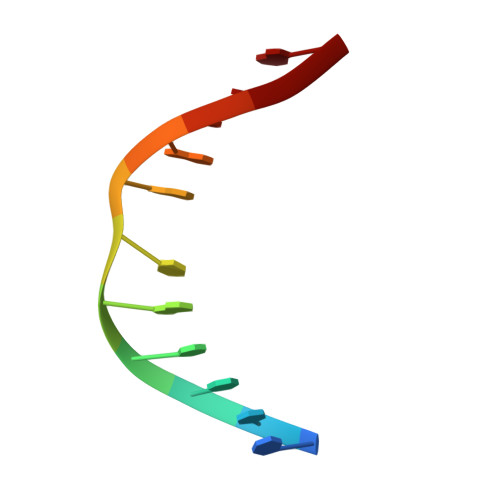Solution Structure of a Cis-Opened (10R)-N6-Deoxyadenosine Adduct of (9S,10R)-(9,10)-Epoxy-7,8,9,10-tetrahydrobenzo[a]pyrene in a DNA Duplex
Volk, D.E., Thiviyanathan, V., Rice, J.S., Luxon, B.A., Shah, J.H., Yagi, H., Sayer, J.M., Yeh, H.J.C., Jerina, D.M., Gorenstein, D.G.(2003) Biochemistry 42: 1410-1420
- PubMed: 12578353
- DOI: https://doi.org/10.1021/bi026745u
- Primary Citation of Related Structures:
1N8C - PubMed Abstract:
The solution structure of an 11-mer DNA duplex, d(CGGTCA*CGAGG) x d(CCTCGTGACCG), containing a 10R adduct at dA* that corresponds to the cis addition of the N(6)-amino group of dA(6) to (+)-(9S,10R)-9,10-epoxy-7,8,9,10-tetrahydrobenzo[a]pyrene was studied by 2D NMR methods. The NOESY cross-peak patterns indicate that the hydrocarbon is intercalated on the 5'-side of the modified base. This observation is the same as that observed for other oligonucleotides containing (10R)-dA adducts but opposite to that observed for the corresponding (10S)-dA adducts which are intercalated on the 3'-side of the modified base. The hydrocarbon is intercalated from the major groove without significant disruption of either the anti glycosidic torsion angle of the modified residue or the base pairing of the modified residue with the complementary residue on the opposite strand. The ensemble of 10 structures determined exhibits relatively small variations (6-15 degrees) in the characteristic hydrocarbon-base dihedral angles (alpha' and beta') as well as the glycosidic torsion angle chi. These angles are similar to those in a previously determined cis-opened benzo[a]pyrene diol epoxide-(10R)-dA adduct structure. Comparison of the present structure with the cis-opened diol epoxide adduct suggests that the absence of the 7- and 8-hydroxyl groups results in more efficient stacking of the aromatic moiety with the flanking base pairs and deeper insertion of the hydrocarbon into the helix. Relative to normal B-DNA, the duplex containing the present tetrahydroepoxide adduct is unwound at the lesion site, whereas the diol epoxide adduct structure is more tightly wound than normal B-DNA. Buckling of the adducted base pair as well as the C(5)-G(18) base pair that lies immediately above the hydrocarbon is much less severe in the present adducted structure than its cis-opened diol epoxide counterpart.
Organizational Affiliation:
Sealy Center for Structural Biology and Department of Human Biological Chemistry and Genetics, University of Texas Medical Branch, Galveston, Texas 77555-1157, USA.
















